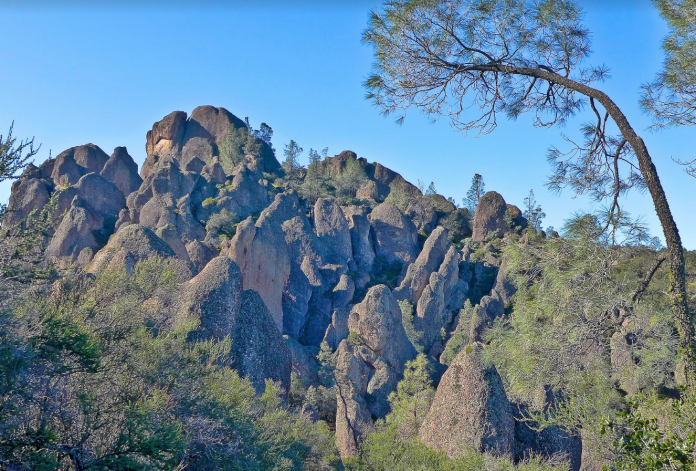
When one thinks of Pinnacles National Park, three special features come to mind: the park’s namesake rocky pinnacles, the unique talus caves, and the resident California condor. Years ago, Barry Breckling, the now retired ranger at Henry Coe State Park, told me about his favorite 7.5-mile loop hike that passed through two of those features and would likely lead to an encounter with the third.
Charlie, a dear friend from Marin County, is fairly new to hiking. Now in his mid-60s, Charlie regularly combs the hills near his home.
“I realized I live in an area surrounded by open space,” he told me. “It was time to get out and see why people had worked so hard to save it. Now, I know. It’s terrific out there.”
Talking Charlie into joining me on Breckling’s loop at Pinnacles was an easy sell. We set a date.
On a weekday morning in early April, we pulled in to a quiet visitor center parking lot at the park’s east entrance south of Hollister on State Route 25. There is also a west side entrance to the park at the end of State Route 146 out of Soledad in the Salinas Valley. The west entrance has limited facilities—no camping or visitor center—and does not connect with east side entrance.
I spoke with Beth Hudick, a park ranger quick to sing the park’s praises.
“Pinnacles is a beautiful, beautiful park,” says Hudick. “What I really love about it is the diversity. We have five different ecosystems with tremendous biodiversity. There’s so much to see here.”
In her role as Head of Interpretation and Education Division, Hudick was in the midst of running the Spring Science Camp.
“Every April, we have a science camp for fourth- and fifth-graders from six nearby schools,” she says. “They camp overnight, and we do some environmental education. For many of the kids, it is their first time camping. It’s a lot of fun.”
After paying the day-use fee in the visitor center, Charlie and I returned to the parking lot to solve our hike’s one “catch”: it ends at Old Pinnacles Trailhead, but begins at the Bear Gulch Day Use Area, a mile and a half away. With gentle diplomacy and my best panhandling skills, I roamed the parking lot hoping to hustle a ride between the two trailheads. My first target, a young couple visiting the park from San Jose, was headed in the same direction. They were glad to help us out.
Pinnacles was promoted from a national monument to a national park in 2013. Since then, visitation has steadily grown.
“We are not a large park,” according to Ranger Hudick. “On weekends, it can be pretty busy, especially in spring. But midweek, even in the early morning or late afternoon on weekends, you can hike for hours and see only one or two people.”
The ranger’s words were prophetic. At the end of a 1,500-foot climb up the Condor Gulch Trail, Charlie and I stepped onto the High Peaks Trail. We had seen no one and would encounter very few people on our long traverse through the forest of volcanic spires ahead.
A warning to those fearful of heights: paths through otherwise impassable portions of the High Peaks Trail climb chiseled toe-hold staircases and scoot along narrow side-stepping ledges, all secured by stout railings, but across heart-stopping exposures that will cause some to shake in their boots.
At a broad overlook at the top of the High Peaks, we stopped for a break. After several minutes, Charlie pointed 20 feet up to the top of the rock spire beside us. A huge black bird with a bald red head and a face only a mother could love busily preened her plumage, totally unconcerned with our presence. It was the first of several California condor sightings.
At the trail junction, we started down the back side of the High Peaks into beautiful Juniper Canyon. Few trails pass through such a lovely landscape. More lush than the east side, Juniper Canyon is an artistic assemblage of rock spires, gray pines, a dense understory, and spring wildflowers. Twice on our descent, we looked up to see a California condor drift silently overhead, held aloft by a ten-foot wingspan.
The Juniper Canyon Trail ended at the west side parking area where we stepped on the Balconies Trail and turned toward home. After a half-mile, we entered a narrow slot between two rock walls, the entrance to the Balconies Caves. We ducked under massive boulders pinched fast by the narrowing gorge. Soon, following the beam of my flashlight, we were ducking, scooting, and sliding through total darkness.
After our hike, I spoke to Jayme Simmons, to learn more about the caves and the park’s geology in general. Simmons is a visitor use assistant at Pinnacles who has a geology degree. “There are a lot of attractions at Pinnacles, but the amazing volcanic rock formations are the reason we became a park,” says Simmons. “They have ridden the San Andreas Fault 200 miles north from the Lancaster area in southern California. Our talus caves were formed by some amazing boulders that have fallen into canyons. They are one of the rarest forms of caves in the world and they house 14 species of bats.”
We emerged from Balconies Caves and walked two level miles back to the car. Tired, but exhilarated, Charlie said our Pinnacles loop had more than met his hike-reward requirement. We had seen amazing sights—a very short distance from home.
Avoid the summer heat, but in spring or fall, Pinnacles National Park is a surprise and a delight.
“There’s so much to see here,” says Hudick. “It’s a really incredible place.”






